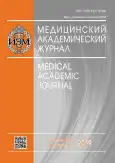СРАВНИТЕЛЬНОЕ ИССЛЕДОВАНИЕ ЭКСПРЕССИИ ЭНДОГЕННОГО РЕТРОВИРУСА ЧЕЛОВЕКА HERV-E λ 4-1 В ИММУННЫХ КЛЕТКАХ КРОВИ БОЛЬНЫХ РАССЕЯННЫМ СКЛЕРОЗОМ
- Авторы: Гольдина ИА1, Маркова ЕВ1,2
-
Учреждения:
- ФГБНУ «НИИ фундаментальной и клинической иммунологии»
- ФГБОУ ВПО «Новосибирский государственный педагогический университет»
- Выпуск: Том 19, № 1S (2019)
- Страницы: 78-80
- Раздел: Статьи
- Статья опубликована: 15.12.2019
- URL: https://journals.eco-vector.com/MAJ/article/view/19334
- ID: 19334
Цитировать
Полный текст
Аннотация
С целью изучения функции эндогенного ретровируса человека HERV-E λ 4-1 в патогенезе рассеянного склероза, проведено сравнительное исследование частоты его экспрессии и уровня мРНК в различных видах иммунных клеток крови больных рассеянным склерозом, прогредиентным типом течения заболевания, с использованием метода обратно-транскриптазной полимеразной цепной реакции. Мононуклеарные клетки периферической крови сепарировали центрифугированием на градиенте плотности Фиколла. Моноциты выделяли при помощи адгезии к пластиковым чашкам Петри. Для оценки митоген-индуцированной экспрессии HERV-E λ 4-1, мононуклеарные клетки крови инкубировали с добавлением фитогемагглютинина или митогена лаконоса в течение 72 часов в CO2 инкубаторе при 37 °C и 5 % CO2. Результаты оценки экспрессии гена env HERV-E λ 4-1 продемонстрировали, что и моноциты, и лимфоциты экспрессируют данный вирус. Уровень экспрессии мРНК HERV-E λ 4-1 env был выше в лимфоцитах, чем в моноцитах. Основным источником экспрессии HERV-E λ 4-1 у больных рассеянным склерозом с прогредиентным типом течения заболевания являются лимфоциты, преимущественно, В лимфоциты.
Ключевые слова
Полный текст
Об авторах
И А Гольдина
ФГБНУ «НИИ фундаментальной и клинической иммунологии»
Е В Маркова
ФГБНУ «НИИ фундаментальной и клинической иммунологии»; ФГБОУ ВПО «Новосибирский государственный педагогический университет»
Список литературы
- Goldina IA, Markova EV. Neiroimmunnye mehanismy patogeneza rasseyannogo sclerosa. Krasnoyarsk: Nauchno-innovacionnyi centr; 2018. 150 p. (In Russ.). https://doi.org/10.12731/978-5-906314-89-5.
- Lander ES, Linton IM, Birren B, et al. Initial sequencing and analysis of the human genome. Nature. 2001;409:860-921. https://doi.org/10.1038/35057062.
- Smagin AA, Goldina IA, Gaidul KV. Issledovanie proliferativnoi aktivnosti mononuclearnyh kletok krovi bolnyh rasseyannym sklerozom pri vozdeistvii peptide regiona envelope endogennogo retrovirusa cheloveka HERV-E λ 4-1. Medicinskaya immunologia. 2014;16(3):247-256. (In Russ.).
- Vargu L, Rodrigues-Tome P, Sperber GO, et al. Classification and characterization of human endogenous retroviruses; mosaic forms are common. Retrovirology. 2016;13:7. https://doi.org/10.1186/s12977-015-0232-y.
- Laufer G, Mayer J, Mueller BF, et al. Analysis of transcribed human endogenous retrovirus W env loci clarifies the origin of multiple-sclerosis associated retrovirus env sequences. Retrovirology. 2009;6:37. https://doi.org/10.1186/1742-4690-6-37.
- Goldina IA, Gaidul KV, Kozlov VA. UFO-inducyrovannaia ekspressia endogennogo retrovirusa cheloveka HERV-E λ 4-1 v mononuclearnyh kletkah krovi. Bulleten sibirskoi mediciny. 2018;17(1):36-44. (In Russ.). https://doi.org/10.20538/1682-0363-2018-1-36-44.
- Goldina IA, Safronova IV, Goldin BG, Gaidul KV. Pattern of relationship of the level of mRNA of human endogenous retrovirus of class I L 4-1 envelope gene and proliferative activity of blood mononuclear cells. International Immunology. 2010;22(S1):i71.
Дополнительные файлы







